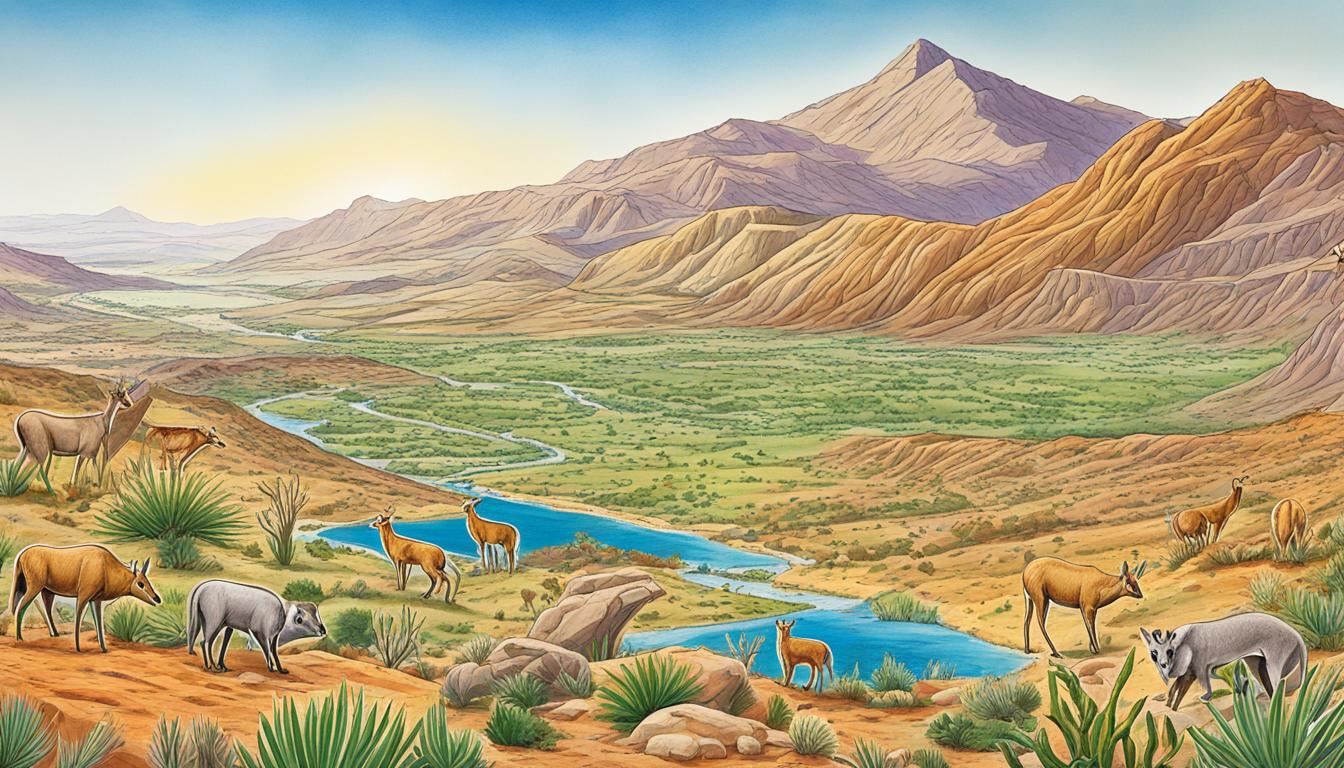Egypt Biodiversity: Animal and Plant Species and What Is Under Threat
Did you know that Egypt is home to over 2,300 flowering plants, 111 mammal species, and 480 bird species? This land of ancient history and majestic pyramids also boasts a rich biodiversity that is teeming with life. From the desert habitats to the wetlands along the Nile, Egypt’s ecosystems are filled with incredible plant and animal species.
Key Takeaways:
- Egypt is home to diverse ecosystems, including desert habitats, wetlands, and marine environments.
- Many plant and animal species in Egypt are already endangered, particularly in coastal ecosystems.
- Habitat destruction, excessive hunting, clear-cutting, pollution, and climate change are the main threats to biodiversity in Egypt.
- Protecting and conserving biodiversity in Egypt is crucial for the sustainable development of the country’s natural resources.
- Efforts are needed to mitigate the threats and secure the future of Egypt’s biodiversity.
Unique Ecosystems in Egypt
Egypt boasts a diverse range of ecosystems, including desert habitats, wetlands, and marine environments. These ecosystems contribute to the country’s rich biodiversity and support various plant and animal species. With 22 distinct habitat groups, Egypt’s landscapes are characterized by rocky surfaces, eroded pavement, gravel deserts, sand dunes, slopes, cliffs, and more. Let’s explore these unique ecosystems and their significance.
Desert Habitats
Egyptian ecosystems include vast desert areas that are home to a wide range of unique plant and animal species. These habitats have adapted to the arid conditions, showcasing remarkable survival strategies. From resilient shrubs like the desert date palm to elusive desert foxes and fennec foxes, the desert ecosystems harbor fascinating biodiversity. The desert plants also play a crucial role in soil stabilization and conservation.
Wetlands along the Nile
The habitat groups in Egypt are not limited to the arid deserts; the wetlands along the Nile River are equally captivating. These areas provide vital ecosystems for numerous plant species, animals, and fish. The wetlands serve as breeding grounds for migratory birds, hosting an astonishing array of species during different seasons. The lush vegetation and abundance of fish create a thriving habitat for several water-loving animals such as hippos and crocodiles.
Coastal Ecosystems
Egypt’s coastal areas are dotted with diverse ecosystems that support a wide variety of marine life. The Red Sea, in particular, stands out for its rich marine biodiversity. Its coral reefs teem with vibrant corals of various shapes and sizes, providing a habitat for an incredible array of fish species. The Red Sea’s underwater world is a paradise for divers and snorkelers, offering a glimpse into a fascinating marine ecosystem.
“Egypt’s ecosystems are an intricate tapestry of life, each habitat group contributing to the country’s ecological diversity. From the harsh yet resilient desert to the fertile wetlands and vibrant coral reefs, Egypt truly is a treasure trove of unique ecosystems.” – Dr. Sarah Ahmed, Marine Biologist
| Habitat Group | Main Characteristics |
|---|---|
| Desert Habitats | Rocky surfaces, eroded pavement, gravel desert, sand dunes |
| Wetlands along the Nile | Lush vegetation, abundance of fish |
| Coastal Ecosystems | Coral reefs, diverse fish species |
Endangered Species in Egypt
Egypt is facing significant challenges in protecting its biodiversity, with many species already endangered. Currently, 51 mammal species, 26 bird species, and 26 reptile species are classified as endangered.
The coastal ecosystems in Egypt are particularly threatened, with at least 17 endangered mammal species, 20 shark species, 300 bird species, and numerous fish, algae, coral, mollusk, and crustacean species at risk. The endangered mangrove ecosystem is also a concern.
Efforts are needed to mitigate the conservation challenges in Egypt and ensure the survival of these species. Threats such as excessive hunting, habitat destruction, pollution, and climate change need to be addressed.
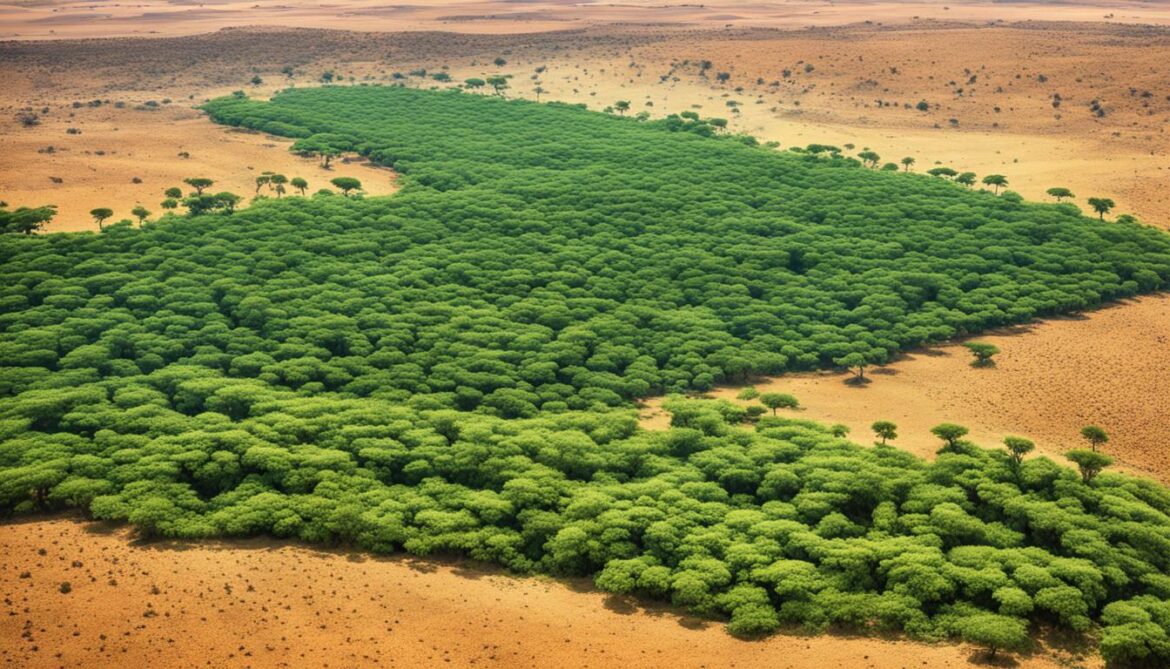
To combat excessive hunting, measures such as enforcing strict regulations and penalties can be implemented. Habitat destruction can be mitigated through the establishment of protected areas and the restoration of degraded habitats. Pollution can be reduced through improved waste management and better enforcement of environmental regulations. Addressing climate change requires a comprehensive approach, including sustainable development strategies.
Conservation organizations, government agencies, and local communities play a vital role in protecting endangered species in Egypt. Collaborative efforts, scientific research, and public awareness campaigns are necessary to create a sustainable future for Egypt’s biodiversity.
“Protecting endangered species is not just a moral obligation; it also ensures the ecological balance and resilience of ecosystems.” – Dr. Ahmed Saleh, Conservation Biologist
By conserving endangered species in Egypt, we can preserve the country’s natural heritage and contribute to the overall health of the planet. Together, we can make a difference and secure a brighter future for these remarkable species.
| Species Group | Number of Endangered Species |
|---|---|
| Mammals | 51 |
| Birds | 26 |
| Reptiles | 26 |
Importance of Biodiversity in Egypt
Biodiversity plays a crucial role in Egypt, offering a multitude of benefits to both the environment and society. The diverse range of species and ecosystems in the country holds immense ecological importance in Egypt and supports various aspects of human life and economic development.
One significant aspect of biodiversity is its genetic components, which contribute to the development of medicinal, agricultural, and industrial products. By studying the genetic makeup of different species, scientists can discover new compounds that may have therapeutic properties or can be utilized in the manufacturing of goods. This research has the potential to revolutionize medical treatments, enhance agricultural practices, and support the growth of local industries.
Additionally, the abundance of flora and fauna in Egypt contributes to the development of new industries, such as ecotourism. The country’s unique ecosystems, including its desert habitats, wetlands, and marine environments, attract nature enthusiasts and adventure seekers from around the world. Ecotourism provides a significant economic boost to local communities, stimulating job creation, and generating revenue for sustainable development projects.
Furthermore, protecting and conserving biodiversity in Egypt is vital for the preservation of its unique ecosystems. These ecosystems are not only rich in their own rights but also provide essential services such as water filtration, soil fertility maintenance, and climate regulation. The interdependence of different species and habitats ensures the overall health and resilience of the natural environment.
In conclusion, the importance of biodiversity in Egypt cannot be overstated. It has ecological significance, economic benefits, and contributes to the sustainable development of the country’s natural resources. By recognizing the value of biodiversity and implementing effective conservation measures, Egypt can ensure the continued prosperity of its ecosystems and the well-being of future generations.
Benefits of Biodiversity in Egypt:
- Development of medicinal, agricultural, and industrial products
- Growth of the ecotourism industry
- Preservation of unique ecosystems and their services
Threats to Biodiversity in Egypt
Egypt’s rich biodiversity faces numerous threats, many of which are directly or indirectly caused by human activities. These threats endanger a wide range of plant and animal species and disrupt the delicate balance of ecosystems. Understanding and addressing these threats are essential for the conservation and preservation of Egypt’s unique biodiversity.
Human Impacts on Biodiversity
Human activities such as excessive hunting, clear-cutting, and deforestation pose significant threats to biodiversity in Egypt. These practices endanger several species of birds and hoofed animals, disrupting their populations and ecosystems. The decline of these species can have cascading effects on the balance and functioning of the natural environment.
“The delicate ecosystems of Egypt are under threat due to excessive hunting and deforestation. We need to take urgent action to protect our unique biodiversity and ensure its survival for future generations.”
Habitat destruction for developmental purposes, including industry and human settlements, is another major threat to biodiversity in Egypt. As urban areas expand and industries grow, natural habitats are being rapidly destroyed and fragmented. This destruction disrupts the interconnected web of life, displaces species from their habitats, and reduces their chances of survival.
Impact of Habitat Destruction in Egypt
The destruction of habitats not only affects individual species but also jeopardizes the intricate relationships and dependencies within ecosystems. Many plant and animal species rely on specific habitats for food, shelter, and reproduction. When these habitats are destroyed, the species that depend on them face an uncertain future.
Coastal pollution is another pressing threat to biodiversity in Egypt. Pollution from industrial activities, urban runoff, and agricultural practices can contaminate the coastal waters, negatively impacting various marine species. These pollutants can disrupt marine ecosystems, harm marine life, and degrade the health and resilience of the coastal environment.
Climate Change and Desertification
Climate change and desertification further exacerbate the threats to biodiversity in Egypt. Rising temperatures, changing rainfall patterns, and increased aridity can alter habitats, disrupt migration patterns, and affect the distribution and abundance of species. These changes place additional stress on already vulnerable ecosystems and species.
To illustrate the extent of these threats, here is a table showing some specific examples of the impacts of human activities on biodiversity in Egypt:
| Threat | Impact |
|---|---|
| Excessive hunting | Endangers bird and hoofed animal species. |
| Clear-cutting and deforestation | Disrupts populations and ecosystems. |
| Habitat destruction | Threatens species and disrupts ecosystems. |
| Coastal pollution | Harms marine life and degrades coastal environments. |
| Climate change and desertification | Alters habitats and affects species distribution. |
Addressing these threats requires collaborative efforts involving governments, communities, and organizations. It is crucial to implement sustainable practices, promote conservation initiatives, and raise awareness about the importance of biodiversity and its preservation. By taking action now, we can protect and sustain the incredible biodiversity that Egypt offers for future generations to enjoy.
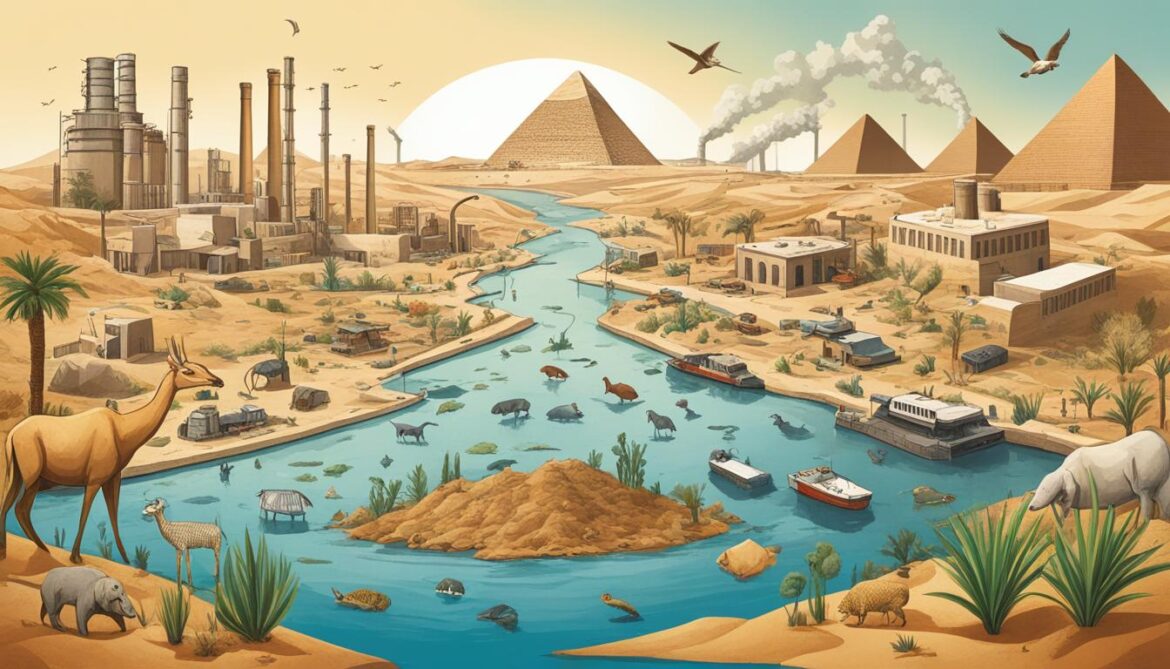
Conservation Efforts in Egypt
Egypt is committed to implementing and enhancing conservation efforts to safeguard its rich biodiversity and protect its natural heritage. The country has undertaken various measures to promote the conservation of ecosystems and species, including the establishment of protected areas, the development of a national biodiversity strategy, and the implementation of conservation programs.
Protected Areas in Egypt
Egypt has created a network of protected areas that represent the diverse ecosystem types found within its borders. These protected areas cover up to 15% of the country’s territory, with a target to increase this figure to 20% by 2017. The protected areas encompass a wide range of habitats, including deserts, wetlands, coastal areas, and marine environments. These areas serve as important sanctuaries for various plant and animal species, providing them with a safe haven where they can thrive and reproduce.
National Biodiversity Strategy in Egypt
In addition to establishing protected areas, Egypt has developed a comprehensive national biodiversity strategy to guide conservation efforts. This strategy aims to conserve and sustainably manage biodiversity, promote the equitable sharing of benefits derived from biodiversity, and enhance public awareness and participation in conservation activities. The national biodiversity strategy sets out clear goals and objectives, outlines priority actions, and provides a framework for collaboration and coordination among different stakeholders.
Conservation Programs
To address threats to biodiversity outside of protected areas, Egypt has implemented conservation programs that focus on important ecosystems and habitats. These programs aim to ensure the conservation and sustainable management of species and ecosystems in areas that are not formally protected. In situ conservation programs focus on protecting species and their habitats in their natural environment, while ex situ conservation programs involve the establishment of captive breeding programs and seed banks to safeguard endangered species and their genetic diversity.
Legislation, Funding, and Monitoring
Egypt has enacted legislation and regulations to support biodiversity conservation, including measures to regulate hunting, trade in endangered species, and habitat destruction. The government has also secured funding from national and international sources to support conservation initiatives and the management of protected areas. To ensure the effectiveness of conservation efforts, Egypt has established monitoring mechanisms to assess the status of biodiversity, track changes over time, and evaluate the impact of conservation interventions.
Efforts towards Sustainable Development
In addition to preserving biodiversity, conservation efforts in Egypt contribute to sustainable development. The protection of ecosystems and the sustainable management of natural resources provide economic opportunities, such as sustainable tourism, which can generate revenue and create employment opportunities. By integrating biodiversity considerations into national policies and strategies, Egypt aims to strike a balance between conservation and development, ensuring the long-term well-being of both people and nature.

| Conservation Efforts in Egypt | Benefits |
|---|---|
| Establishment of protected areas | – Preservation of unique ecosystems – Protection of endangered species – Promotion of ecotourism |
| National biodiversity strategy | – Guidance for conservation efforts – Coordination among stakeholders – Enhancement of public awareness |
| Conservation programs | – Conservation of important habitats – Protection of species outside protected areas – Endangered species recovery |
| Legislation and funding | – Regulation of hunting and trade – Securing financial resources – Support for protected area management |
| Monitoring and evaluation | – Assessment of biodiversity status – Tracking changes over time – Evaluation of conservation interventions |
Implementation of the National Biodiversity Strategy
Egypt is actively implementing its National Biodiversity Strategy and Action Plan (NBSAP) to promote sustainable development, harmonize conservation efforts, and prioritize crucial actions. The NBSAP serves as a framework for effectively managing natural resources and protecting biodiversity in Egypt, ensuring a balanced approach to development and conservation.
Protecting and Managing Protected Areas
One of the key aspects of implementing the NBSAP is the development and management of protected areas. These areas play a vital role in safeguarding important ecosystems and conserving species diversity. Egypt is focused on expanding its network of protected areas, preserving unique habitats and providing spaces for threatened flora and fauna to thrive.
“Protected areas are crucial for ensuring the long-term conservation of Egypt’s invaluable biodiversity.” – Dr. Ahmed El Sayed, Director of the Egyptian Environmental Affairs Agency
Prioritizing Biodiversity Assessment and Monitoring
A crucial component of the NBSAP implementation is the continuous assessment and monitoring of biodiversity. Regular evaluations help identify changes in species populations, measure the effectiveness of conservation efforts, and guide future actions. By monitoring biodiversity, Egypt can make informed decisions and adapt conservation strategies accordingly.
Institutional Development and Capacity Building
The successful implementation of the NBSAP relies on building strong institutions and enhancing capacity at various levels. Egypt is investing in the development of institutions dedicated to biodiversity conservation, such as the National Biodiversity Unit (NBU). Through capacity-building programs, professionals are equipped with the knowledge and skills needed to effectively manage and protect Egypt’s biodiversity.
Fostering Partnerships for Biodiversity Conservation
Collaboration among stakeholders is crucial for the effective implementation of the NBSAP. Egypt recognizes the value of partnerships with local communities, non-governmental organizations, research institutions, and international entities. The formation of partnerships allows for the sharing of expertise, resources, and experiences, fostering a collective effort towards biodiversity conservation.
Revision of the NBSAP
Efforts are currently underway to revise the NBSAP in order to strengthen Egypt’s biodiversity conservation initiatives and align with international commitments. This revision process aims to enhance the effectiveness of conservation measures, address emerging challenges, and incorporate new knowledge and best practices.
By implementing the National Biodiversity Strategy and Action Plan, Egypt is taking significant strides towards conserving and protecting its diverse natural heritage. Through strong institutional frameworks, proactive monitoring, and active partnerships, Egypt is committed to ensuring the long-term sustainability of its unique ecosystems and the valuable species that call them home.
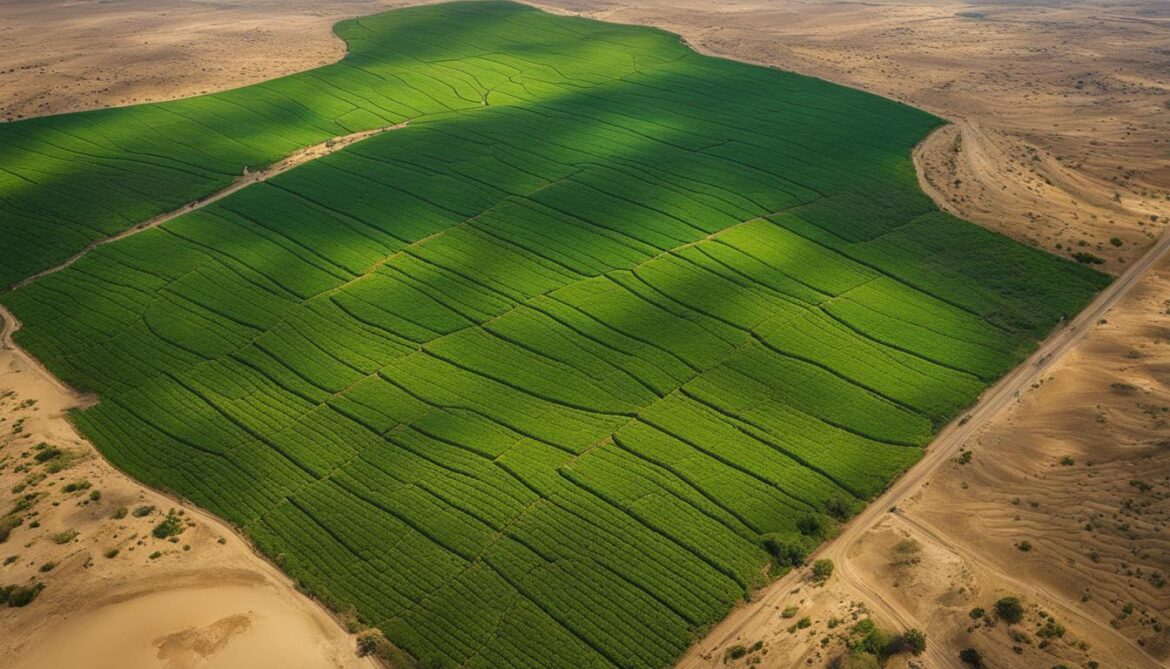
International Commitments and Support Mechanisms
Egypt has actively participated in international and regional agreements to ensure the conservation of biodiversity. The country has become a party to various conventions and treaties, including the Convention on Biological Diversity and the Convention on International Trade in Endangered Species of Wild Fauna and Flora (CITES). By joining these agreements, Egypt has demonstrated its commitment to preserving its unique ecosystems and protecting endangered species.
Egypt has also established national structures and strategies to effectively implement these international commitments on biodiversity. Through the formation of dedicated agencies and the development of comprehensive strategies, the country has taken concrete steps towards biodiversity conservation. These national efforts contribute to the wider global agenda of safeguarding biodiversity and promoting sustainable development.
In order to realize its conservation goals, Egypt has mobilized support mechanisms from both national and international sources. These mechanisms provide the necessary funding, expertise, and resources to implement biodiversity conservation projects within the country. By leveraging these support mechanisms, Egypt can effectively address the challenges faced by its diverse ecosystems and endangered species.

The Convention on Biological Diversity
The Convention on Biological Diversity (CBD) is a landmark international agreement that aims to promote the conservation and sustainable use of biodiversity, as well as the fair and equitable sharing of benefits arising from genetic resources. Egypt became a party to the CBD in 1994, highlighting its commitment to the protection and preservation of its rich ecological heritage. By aligning its national strategies with the CBD’s objectives, Egypt is taking bold steps towards achieving global biodiversity targets.
The Convention on International Trade in Endangered Species of Wild Fauna and Flora (CITES)
CITES is an international agreement that regulates the trade in endangered species to prevent their exploitation and ensure their survival. Egypt’s participation in CITES reflects its dedication to combat illegal wildlife trade and protect endangered species within its borders. By adhering to CITES regulations, Egypt plays a crucial role in preserving global biodiversity and fostering sustainable trade practices.
Through its international commitments and support mechanisms, Egypt is actively working towards the conservation of its biodiversity. By collaborating with global partners and implementing comprehensive conservation strategies, Egypt is positioning itself as a leader in biodiversity protection and sustainable development.
Monitoring and Evaluation of Biodiversity Conservation
Egypt recognizes the importance of monitoring and evaluating its efforts in biodiversity conservation. To ensure effective conservation measures, the country has established the National Biodiversity Unit (NBU). The role of the NBU is to oversee and monitor the progress of biodiversity conservation initiatives throughout Egypt.
One of the key tools developed by the NBU is the biodiversity database. This database serves as a central repository, connecting scientific establishments and referral collections. It facilitates the sharing of data and supports research on various taxonomic groups within the country. By consolidating information and fostering collaborations, the database strengthens the understanding and management of Egypt’s diverse biodiversity.
Egypt is committed to making its biodiversity database globally accessible through the web. This move will not only promote international collaboration but also contribute to a deeper understanding of Egypt’s unique ecosystems and species. Accessible and comprehensive data is essential for informed decision-making and the development of effective conservation strategies.

Reports Enhancing Knowledge and Understanding
In addition to the biodiversity database, Egypt’s conservation efforts are supported by reports produced by national experts. These reports cover various aspects of biodiversity, including ecosystems, mammals, reptiles, birds, plants, fungi, and other components of Egypt’s rich natural heritage.
These expert reports serve multiple purposes. They provide valuable insights into the current state of biodiversity, highlighting areas of concern and identifying species that require immediate conservation attention. Furthermore, these reports contribute to our understanding of the complex interactions within ecosystems and the threats faced by different taxonomic groups.
“Expert reports play a crucial role in enhancing our knowledge and understanding of Egypt’s biodiversity. They provide essential information for guiding conservation efforts and making informed policy decisions.”
By continuously monitoring and evaluating biodiversity conservation, Egypt can adapt its strategies to address emerging challenges effectively. The biodiversity database and expert reports are valuable resources that empower policymakers, researchers, and conservation practitioners to work together towards the preservation of Egypt’s precious natural heritage.
| Biodiversity Database | Reports |
|---|---|
| Central repository for biodiversity data | Provide insights into the current state of biodiversity |
| Connect scientific establishments and referral collections | Highlight areas of concern |
| Facilitate data sharing and research | Identify species requiring immediate conservation attention |
| Support decision-making and conservation strategies | Enhance understanding of ecosystem interactions |
Importance of Collaboration and Future Directions
Collaboration is key to the success of biodiversity conservation in Egypt. By bringing together government agencies, research institutions, local communities, and international partners, we can work towards a common goal of preserving the country’s unique ecosystems and protecting its diverse plant and animal species.
As we look towards the future, there are several important directions we need to take to ensure the long-term sustainability of biodiversity conservation in Egypt. These directions include:
- Strengthening Protected Area Management: We must focus on enhancing the management of protected areas in Egypt to safeguard these critical habitats and the species that depend on them. This involves implementing effective monitoring and enforcement measures, as well as conducting research to better understand the ecological dynamics within these areas.
- Expanding Conservation Efforts Beyond Protected Areas: While protected areas play a crucial role, we need to extend our conservation efforts beyond these designated zones. This means identifying and protecting important habitats outside of protected areas, such as key migration routes, critical breeding sites, and significant feeding grounds for migratory birds and other wildlife.
- Promoting Sustainable Tourism: Tourism can be a powerful tool for biodiversity conservation in Egypt. By promoting sustainable tourism practices, we can create economic incentives for local communities to support conservation efforts. This includes developing guidelines for eco-friendly tourism activities, supporting community-based tourism initiatives, and raising awareness among tourists about the importance of preserving Egypt’s natural heritage.
- Addressing the Impact of Climate Change: Climate change poses a significant threat to biodiversity in Egypt. We need to prioritize climate change adaptation strategies and incorporate them into biodiversity conservation plans. This may involve implementing measures to protect vulnerable species and habitats from the impacts of climate change, as well as promoting sustainable land and water management practices to enhance ecosystem resilience.
- Integrating Biodiversity Considerations into National Policies and Strategies: Biodiversity conservation should be mainstreamed into various sectors and decision-making processes. By integrating biodiversity considerations into national policies, strategies, and development plans, we can ensure that ecological sustainability becomes a core principle in all aspects of governance and development.
- Education and Public Awareness: Building a culture of conservation and responsible use of natural resources requires education and public awareness. We need to invest in environmental education programs, engage local communities in conservation activities, and raise awareness among the general public about the value of biodiversity and the importance of its conservation.
By embracing collaboration and focusing on these future directions, we can create a sustainable future for biodiversity conservation in Egypt. Together, we can protect and preserve the incredible natural heritage of this country for generations to come.
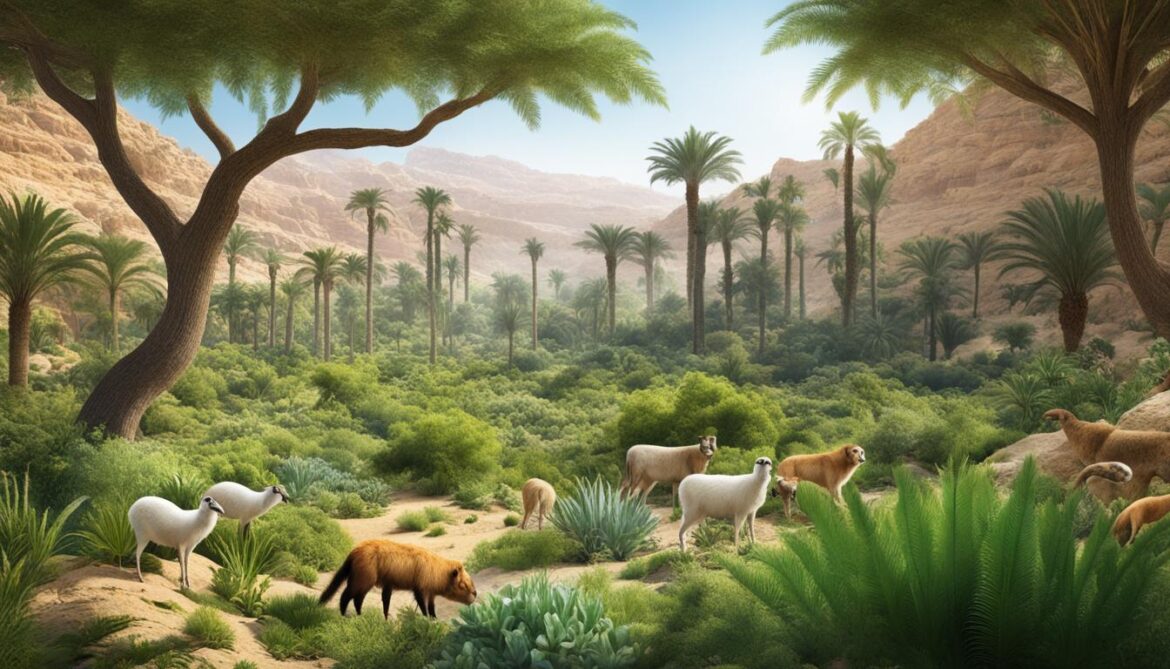
Conclusion
Egypt is home to a rich biodiversity, with unique ecosystems, diverse plant and animal species, and globally important habitats. The country’s desert habitats, wetlands along the Nile, and the Red Sea marine environment support a wide range of flora and fauna. However, this valuable biodiversity is under threat from various human impacts, including habitat destruction, pollution, and climate change.
To ensure the survival of species and the sustainable development of natural resources, it is crucial that efforts to protect and conserve Egypt’s biodiversity continue. The establishment of protected areas, implementation of the National Biodiversity Strategy, and international collaborations play a vital role in safeguarding the country’s ecosystems and species. Ongoing monitoring, research, and public awareness are also essential for addressing the ongoing challenges and securing the future of Egypt’s biodiversity.
By prioritizing biodiversity conservation, Egypt can not only preserve its unique ecosystems but also reap economic benefits. Biodiversity contributes to the development of industries such as ecotourism and provides genetic resources for medicinal, agricultural, and industrial purposes. By valuing and protecting its natural heritage, Egypt can support sustainable development while safeguarding the ecological balance and the well-being of future generations.




